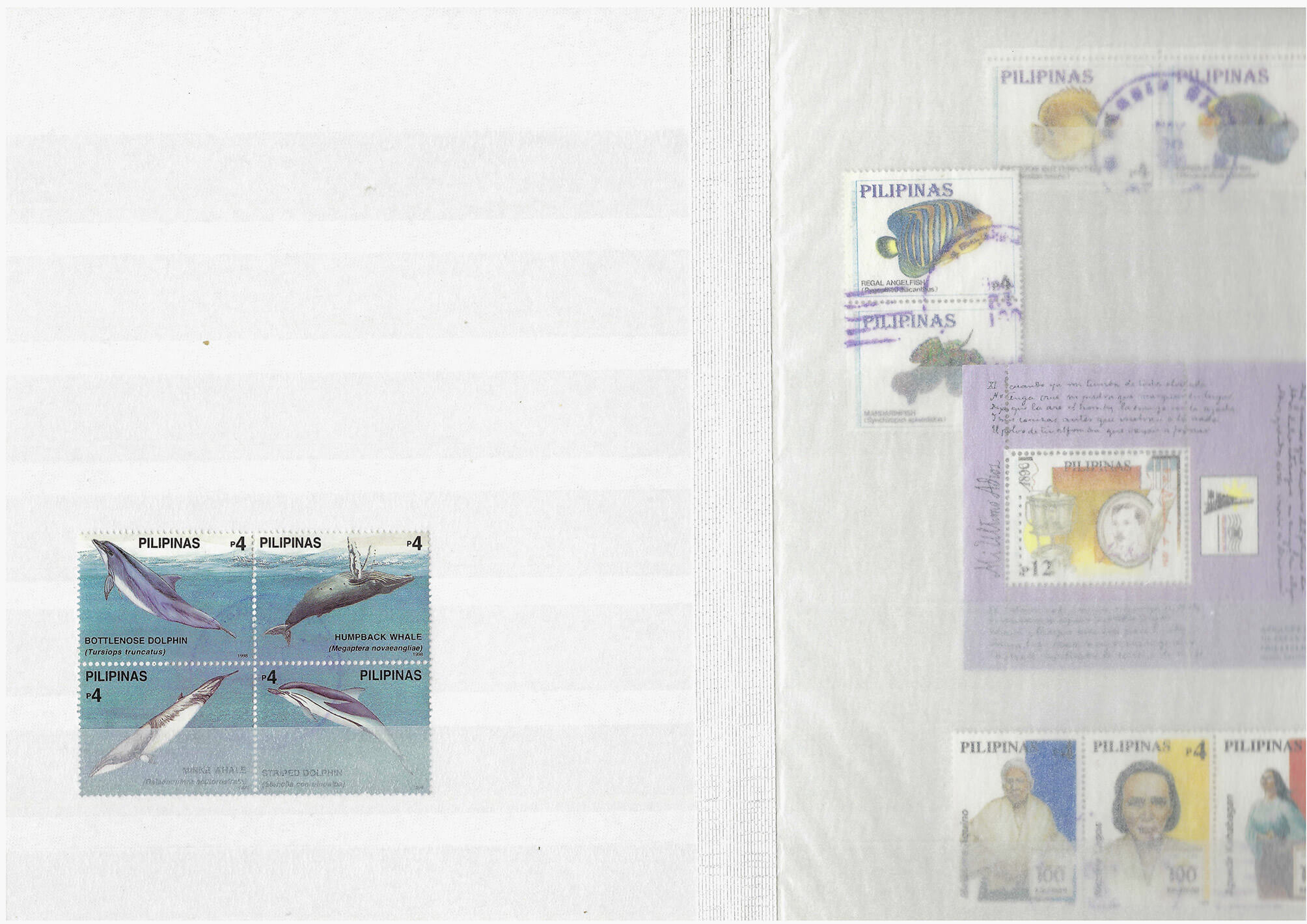What constitutes a ‘document’ and how does it function?
According to the Oxford English Dictionary, the etymological origin is the Latin ‘documentum’, meaning ‘lesson, proof, instance, specimen’. As a verb, it is ‘to prove or support (something) by documentary evidence’, and ‘to provide with documents’. The online version of the OED includes a draft addition, whereby a document (as a noun) is ‘a collection of data in digital form that is considered a single item and typically has a unique filename by which it can be stored, retrieved, or transmitted (as a file, a spreadsheet, or a graphic)’. The current use of the noun ‘document’ is defined as ‘something written, inscribed, etc., which furnishes evidence or information upon any subject, as a manuscript, title-deed, tomb-stone, coin, picture, etc.’ (emphasis added).
Both ‘something’ and that first ‘etc.’ leave ample room for discussion. A document doubts whether it functions as something unique, or as something reproducible. A passport is a document, but a flyer equally so. Moreover, there is a circular reasoning: to document is ‘to provide with documents’. Defining (the functioning of) a document most likely involves ideas of communication, information, evidence, inscriptions, and implies notions of objectivity and neutrality – but the document is neither reducible to one of them, nor is it equal to their sum. It is hard to pinpoint it, as it disperses into and is affected by other fields: it is intrinsically tied to the history of media and to important currents in literature, photography and art; it is linked to epistemic and power structures. However ubiquitous it is, as an often tangible thing in our environment, and as a concept, a document deranges.
the-documents.org continuously gathers documents and provides them with a short textual description, explanation,
or digression, written by multiple authors. In Paper Knowledge, Lisa Gitelman paraphrases ‘documentalist’ Suzanne Briet, stating that ‘an antelope running wild would not be a document, but an antelope taken into a zoo would be one, presumably because it would then be framed – or reframed – as an example, specimen, or instance’. The gathered files are all documents – if they weren’t before publication, they now are. That is what the-documents.org, irreversibly, does. It is a zoo turning an antelope into an ‘antelope’.
As you made your way through the collection,
the-documents.org tracked the entries you viewed.
It documented your path through the website.
As such, the time spent on the-documents.org turned
into this – a new document.
This document was compiled by ____ on 03.10.2023 16:51, printed on ____ and contains 26 documents on _ pages.
(https://the-documents.org/log/03-10-2023-5452/)
the-documents.org is a project created and edited by De Cleene De Cleene; design & development by atelier Haegeman Temmerman.
the-documents.org has been online since 23.05.2021.
- De Cleene De Cleene is Michiel De Cleene and Arnout De Cleene. Together they form a research group that focusses on novel ways of approaching the everyday, by artistic means and from a cultural and critical perspective.
www.decleenedecleene.be / info@decleenedecleene.be - This project was made possible with the support of the Flemish Government and KASK & Conservatorium, the school of arts of HOGENT and Howest. It is part of the research project Documenting Objects, financed by the HOGENT Arts Research Fund.
- Briet, S. Qu’est-ce que la documentation? Paris: Edit, 1951.
- Gitelman, L. Paper Knowledge. Toward a Media History of Documents.
Durham/ London: Duke University Press, 2014. - Oxford English Dictionary Online. Accessed on 13.05.2021.

My dream hollyday We were a football
on the beach
We were a modern house.
We were a We swim in the swimming
pool.
June 2022, Marche-en-Famenne. I arrived half an hour early. Waiting for my family to pick me up at the station, near a linden tree, I found a yellow page lying on the pebbles in front of the wooden bench I sat on. It had been a hot day. The sun was finally setting. Music playing in the distance. A white Volkswagen. Windows closed. Hard basses, trembling across the road. Folded three times, the sheet of paper had the size of a DIN A7. A white BMW pulled over. Seven glass jars in a container.
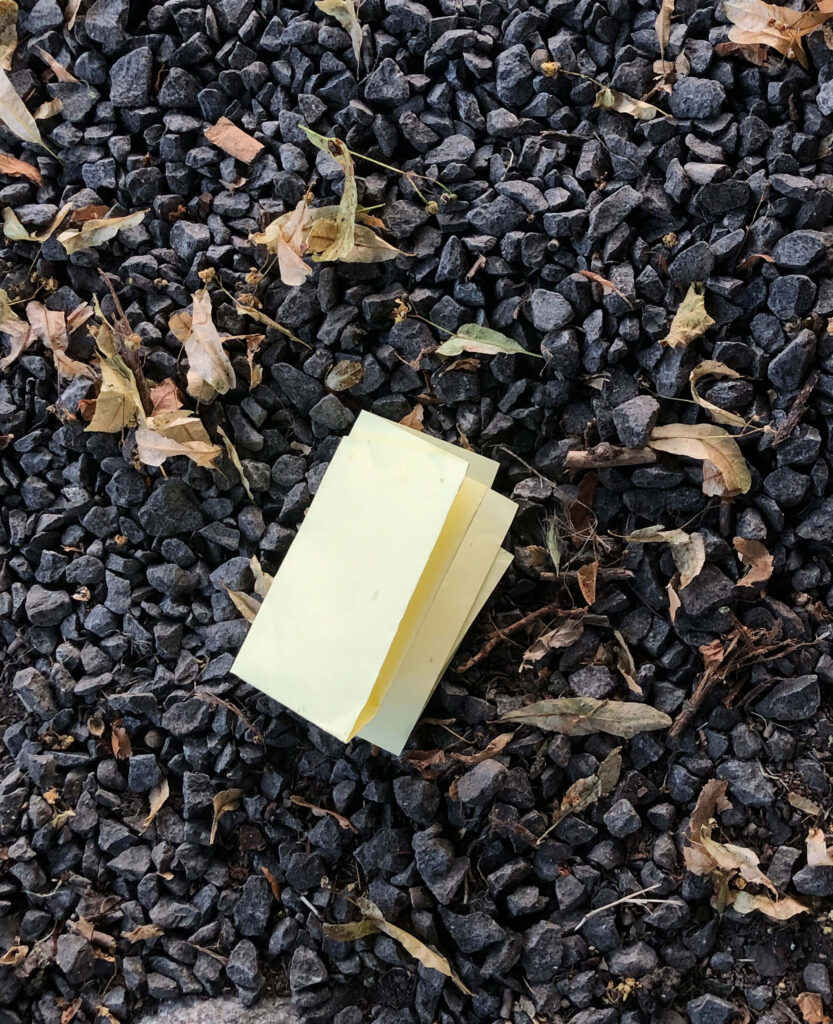
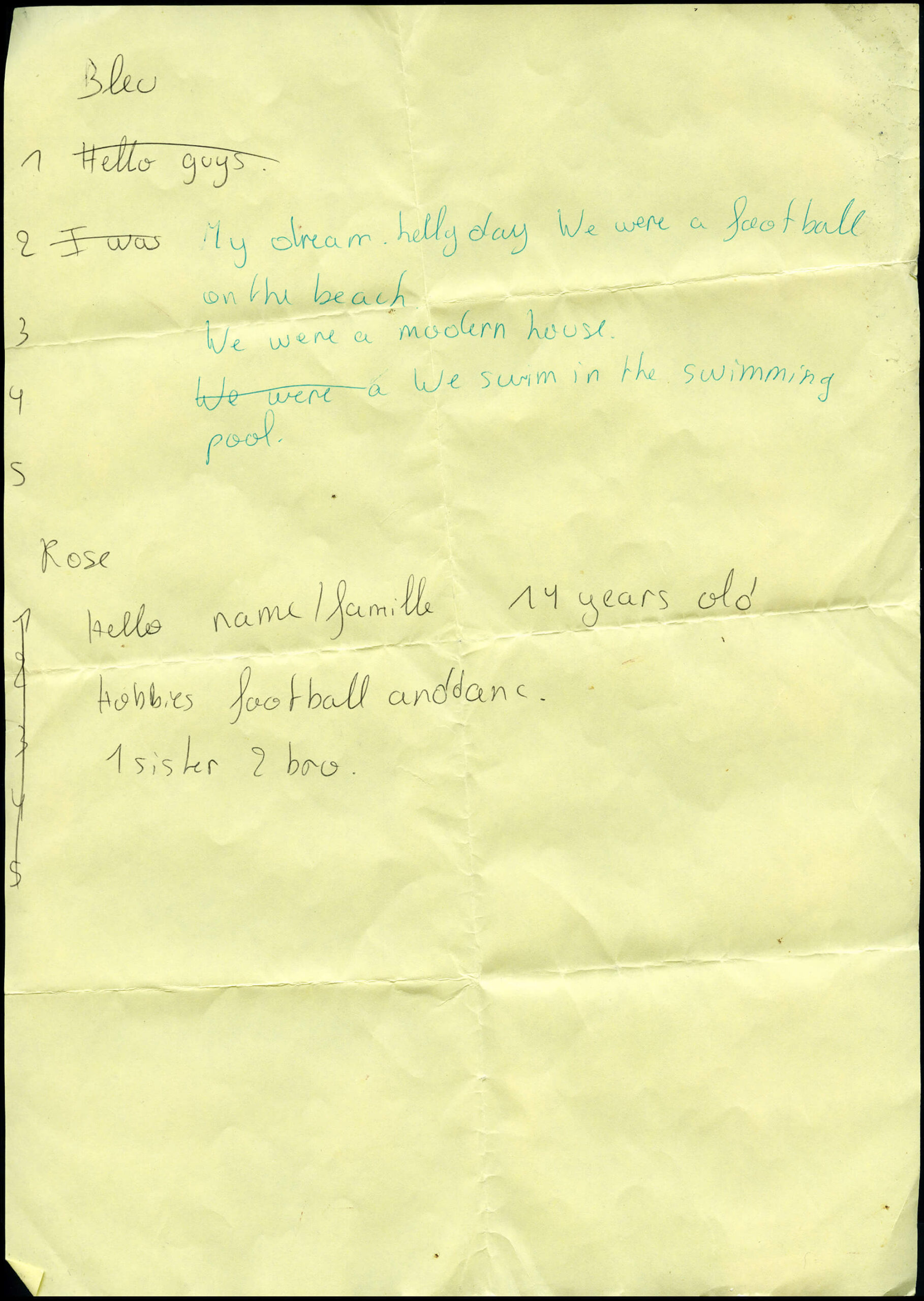
The scientific exactitude sought for in the Iconographie de la Salpêtrière and the Nouvelle Iconographie de la Salpêtrière, the (in)famous scientific publications stemming from Paris’ psychiatric hospital La Salpêtrière (1876-1918), lead to an abundance of photographic images in their pages. The photographs’ ideal: ‘Trace incontestable, incontestablement fidèle, durable, transmissible’.1 The ambition of exactitude results in cold, and often cruel depictions of patients. In the digitized version of the Sorbonne library’s copies, some photographs have left an imprint on the opposite page. The knee of Charles, ‘le géant’, adds an unwanted layer upon its measures on the opposite page, while the photograph of the knee itself loses ink.2
Didi-Huberman, G. Invention de l’hystérie. Paris: Macula, 2014, 72.
Launois, P.-E., Roy, P., ‘Gigantisme et infantilisme’, Nouvelle Iconographie de la Salpêtrière, Tome XV, 1902, 548, pl. LXVI, online: https://patrimoine.sorbonne-universite.fr/fonds/item/2613-nouvelle-iconographie-de-la-salpetriere-tome-15?offset=6

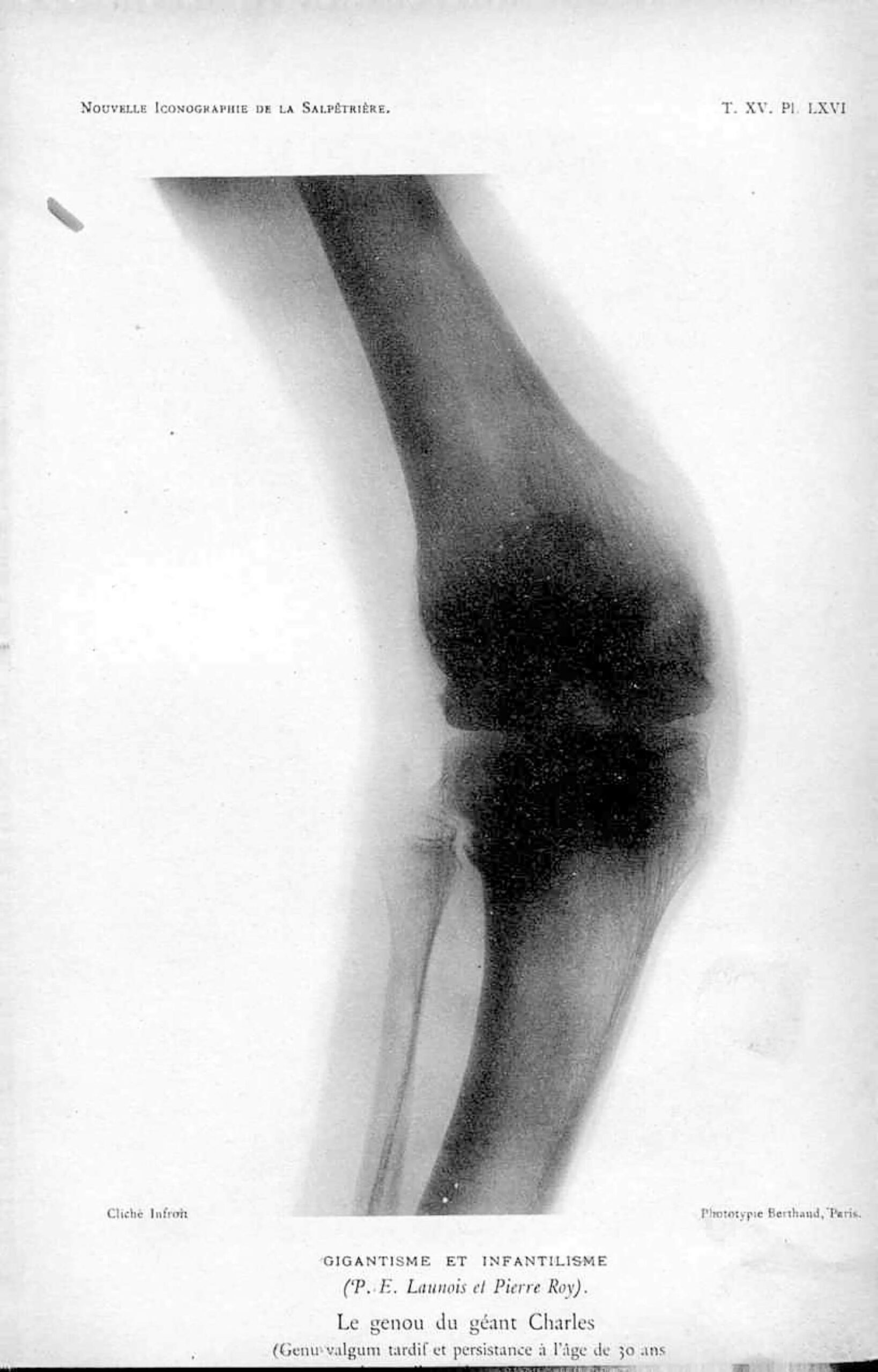
Until recently, for as long as I could remember, the packaging of Tabasco® Pepper Sauce had been unchanged. On the front of the packaging, there is a photograph of a bottle of Tabasco®, scale 1:1, against an orange background.As far as packaged goods go, this is a highly idiosyncratic and quirky example.
The background colour approximates the colour of the liquid inside the bottle, resulting in as good as no contrast. Moreover, as the image of the bottle is scale 1:1, the packaging becomes kind of unnecessary and superfluous, also because the life-sized image of the bottle is the only way information is given to the customer: there are no additional slogans, no repetition of the brand name, no props and no decor. The image of the bottle advertises the bottle. It seems to add nothing the bottle could not do by its own (like a bottle of wine does).
What makes the packaging truly stand out, however, is the fact that the image of the bottle is not positioned vertically, but is slightly askew. It seems to be the result of a design error, and has an amateur feel to it. The decision to keep it as such and not correct it up until today, is, however, a stroke of genius. The non-vertical positioning alters the relation of the image of the bottle to the bottle inside: as the box is standing on a shelf, the tilted image of the bottle undermines its representational superfluousness.

This stack of seaweed was offered by Henning, a farmer of the wonderful island of Laeso. This matriarchal pirate island, north of Denmark, is known for its tradition of building roofs from the seaweed growing in the surrounding salty water. Back in time, women would harvest and slowly weave the material around wooden beams from shipwrecks. This time-consuming process and technique of building shelters from what comes from the sea engaged the population in working together, building a ritual around each construction. Then those wild, yet full-of-care roofs, conserved in salt, would last for hundreds of years.
When I arrived on his land, Henning told me about how he restores those old beauties, weaving fresh seaweed around old beams and pressing the collected old material into insulation panels for new buildings. We talked about the clay of his land and how seaweed can become a material for ceramics in the process of making glazes.
Clementine Vaultier’s interests, although trained as a ceramist, are in the warm surroundings of the fire rather than the production it engenders.

This is a trace, and it is not.
Ceci est une trace et ne l’est pas.
What is a trace?
Qu’est-ce qu’une trace?
Le document n’en est pas, le document documente.
Documents what?
Peu importe, le mot ‘document’ est dérivé du latin docere, c’est à dire…
to show, to teach, to instruct. The document is docile, unlike the trace.
La trace ne montre pas, n’enseigne pas, n’instruit en rien, à moins d’interpréter.
The trace as indexical: it does not ‘show’ though one can see it. It does not teach,
sauf que tout nous pré-existe, ou plutôt, nous insiste, n’est-ce pas?
It doesn’t: it’s never there as such until we name it so.
Documenti!
Papiere!
Poètes, vos papiers!
(Léo Ferre 1956)
Le document.
Le dos-cul ment.
Le d’au-cul ment.
Le dé au cul ment.
Mais co-ment?
Butt how?
The do-cum-meant.
The doc-cue-mint.
The dock-comment.
This is a cardboard mousepad.
Are you happy now?
Are you happy?
Are you?
Now?
document: a paper or set of papers with written or printed information, especially of an official type.
(https://dictionary.cambridge.org/us/dictionary/english/document)
‘He’s more of an official type.’
A document is a written, drawn, presented, or memorialized representation of thought, often the manifestation of non-fictional, as well as fictional, content.
(https://en.wikipedia.org/wiki/Document)
‘She was quite content.’
Tha back-ass lies!
Sébastien Conard (1982) is a graphic artist, writer and teacher. He draws, writes and publishes comics, post-comics and artist’s books. From 2023 until 2026, he will explore the graphic trace in the context of a postdoctoral research project at LUCA School of Arts.
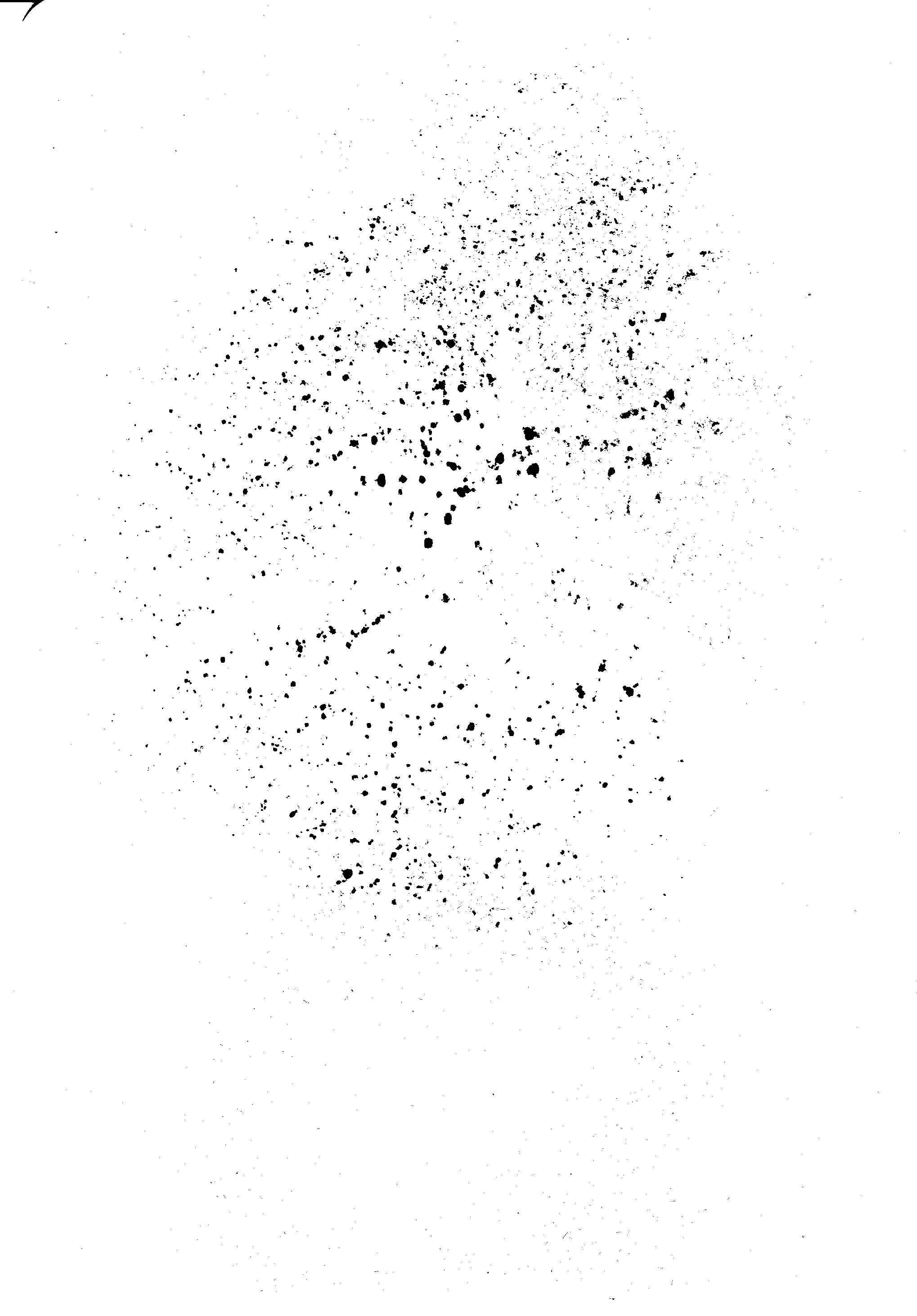
To detect gravitational waves, physicists built enormous research centers, amongst others at Livingston, Louisiana. The facility mainly consists of two tunnels in an L-shape. Mirrors inside provide data. Disturbances from gravitational waves are miniscule. To prevent interference from outside, such as vibrations caused by people passing in the neighbourhood, the mirrors have to be detached from the earth. They ‘float’, suspended by glass fibers in a pendulum-like construction. As I was watching my screen, a courier was on his way to deliver a book (Noel-Todd, J. The Penguin Book of the Prose Poem: From Baudelaire to Anne Carson. London: Penguin, 2019).
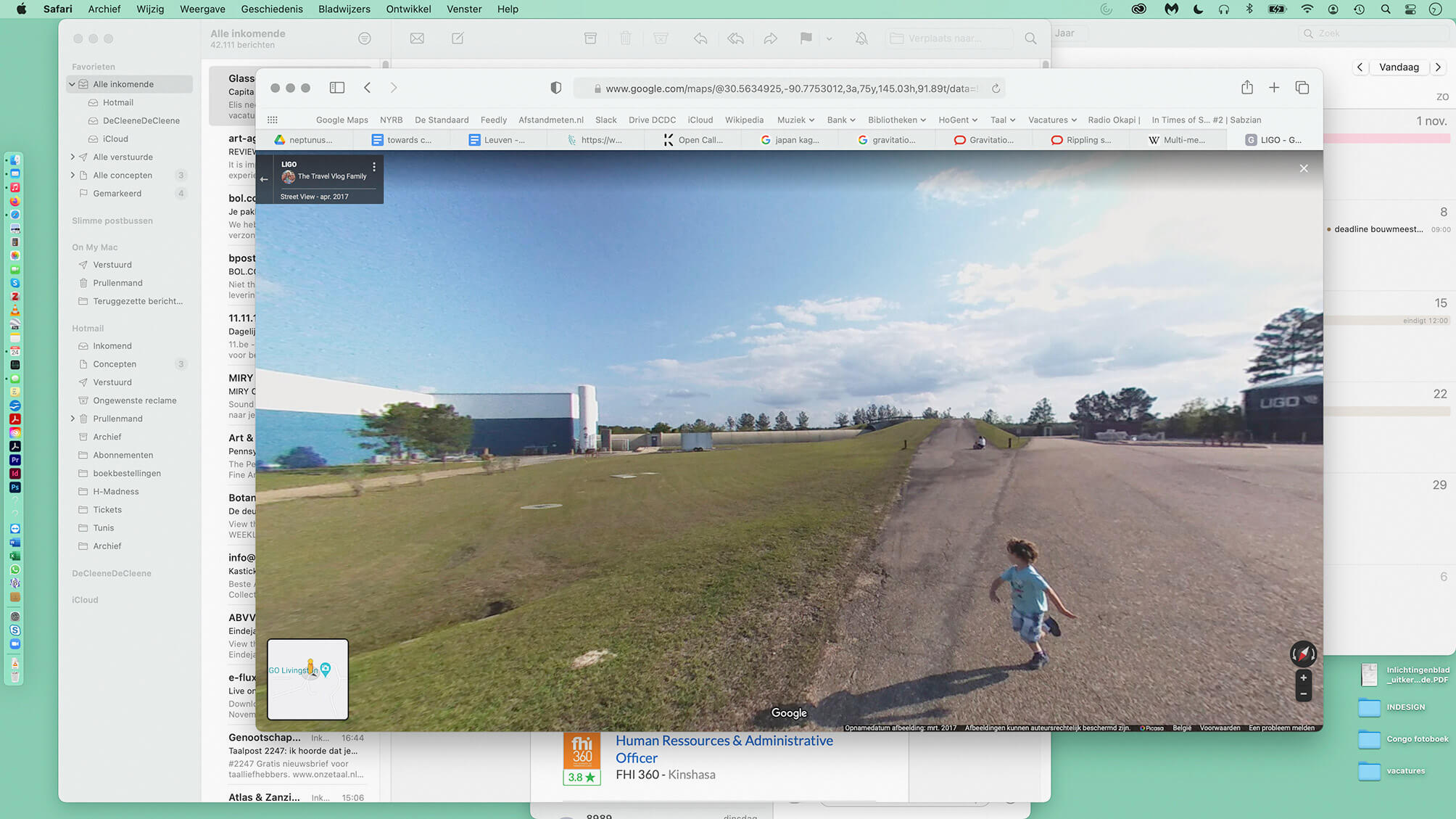
The Sedum reflexum grows on rocky soils and in crevices of walls. In L’herbier classique, it is depicted in two ways, just like the other plants in the book. This double portraiture is important, the author states in the introduction: ‘one consists of the reproductions of the photographs taken by the author of this book […]; the other, drawings made by excellent artists who observed the plants themselves, showing details photography can’t reproduce, highlighting aspects the photographs leave untouched. […] From this double representation, interesting comparisons can be made, highly enlightening from an artistic point of view, between the realistic aspect of nature’s “productions” and the interpretation thereof by the draftsman’ (5).
A detail not covered by the drawing of the sedum reflexum, is the presence of other species in the vicinity of the plant, a detail shown in the photograph and described in the caption: ‘The Common houseleek grows on the same rocks, with its rosette of leaves pretending to be an artichoke’ (59).
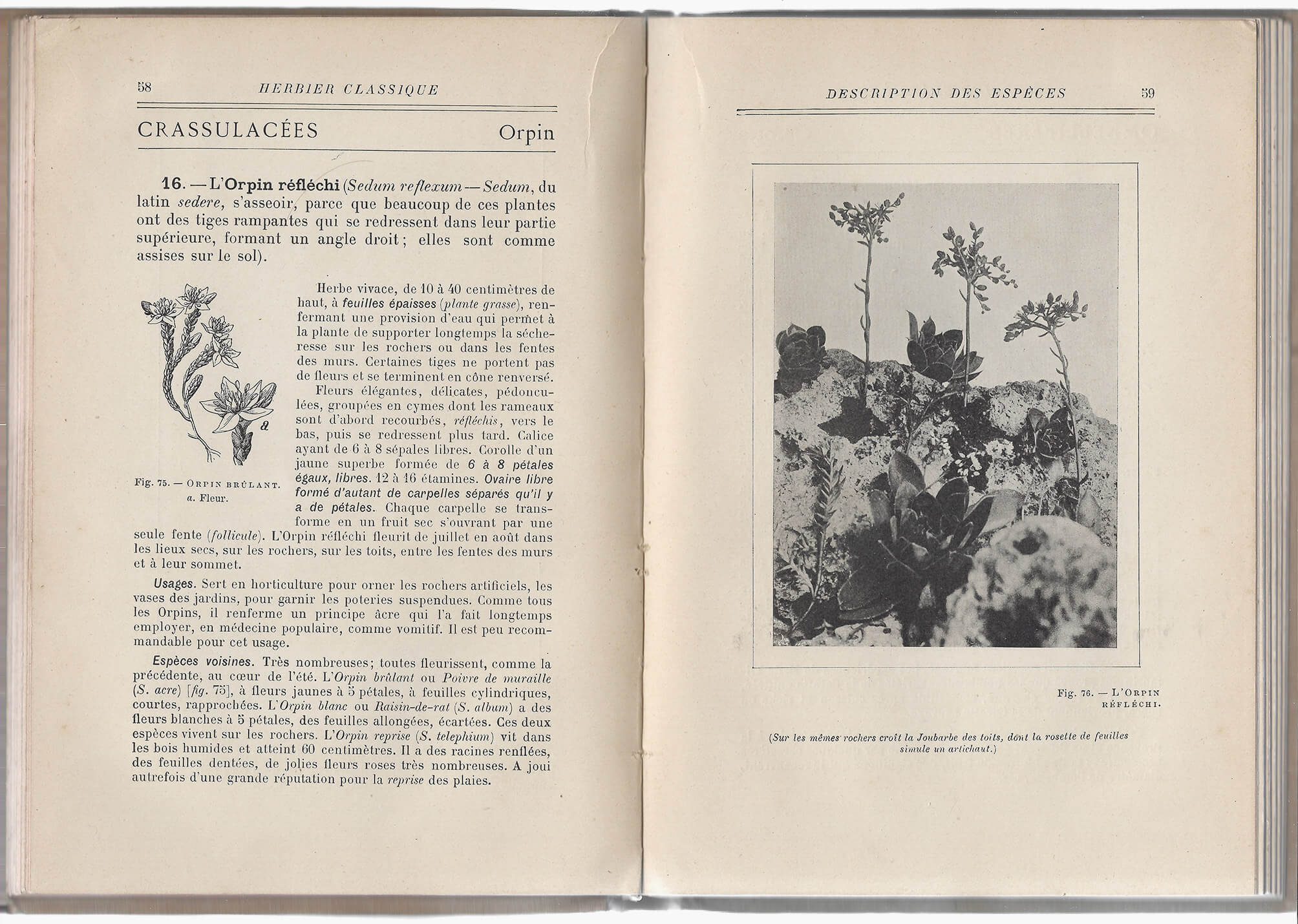
In what order and by whom the various texts and drawings were carved into the soft roofing is unclear. To the right of ‘EVA’, a heart symbol and an arrow (pointing to the left), the roofing reads ‘SIMON TU ME MANQUES’.
The short sentence usually – yet hastily – translates to ‘Simon, I miss you’. However, in French the ‘you’ (tu) is the subject and has an active role, whereas the ‘I’ (me) is the direct object. In short: by his not being there, Simon actively effectuates hurt to the one who carved this text.
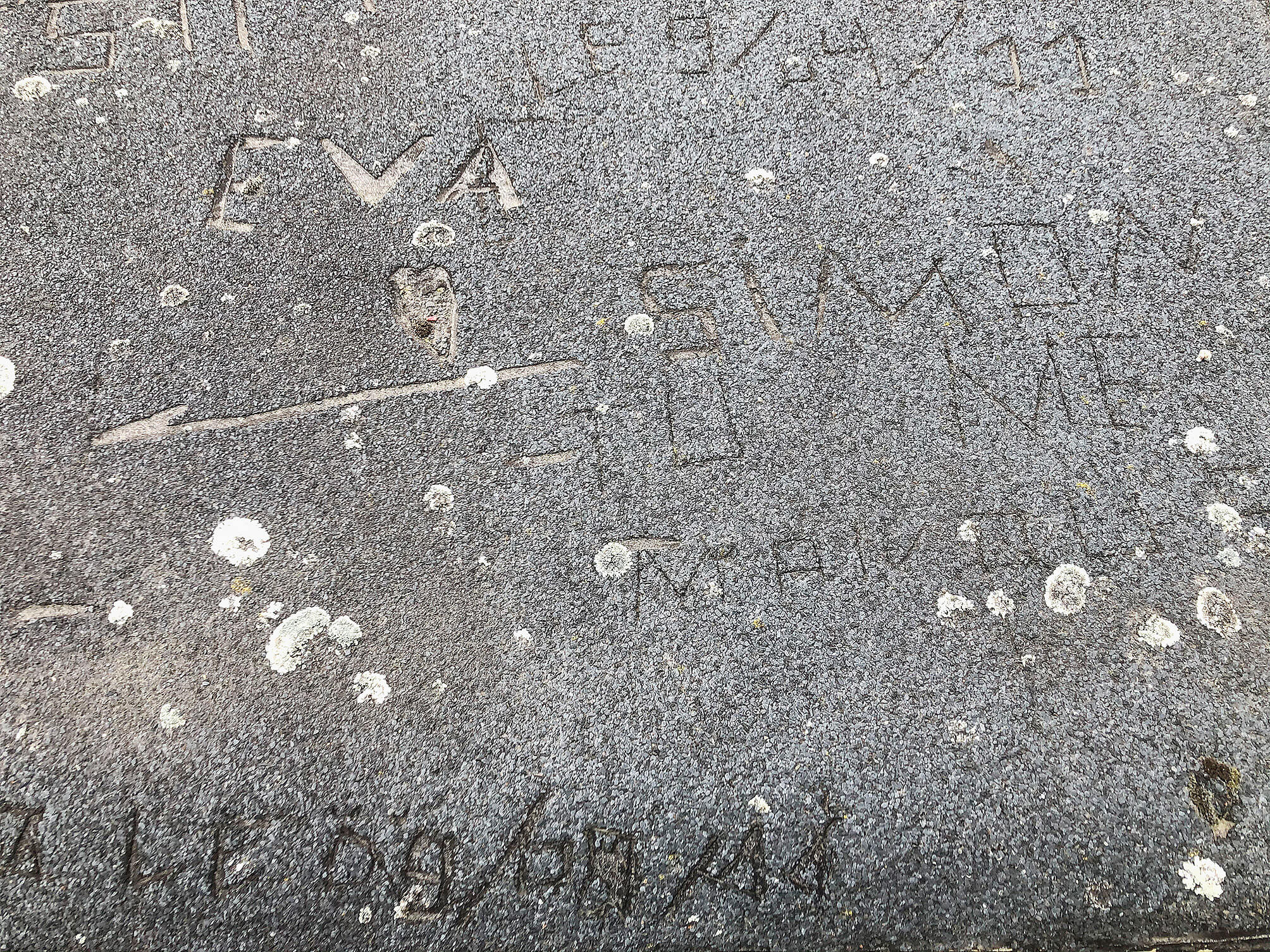
At the copyshop, on a shelf above photocopier 8, the lid of a box of paper serves as the container for ‘forgotten originals’.1
The book being copied: Didi-Huberman, G. La ressemblance par contact. Archéologie, anachronisme et modernité de l’empreinte. Paris: Les Editions de Minuit, 2008.
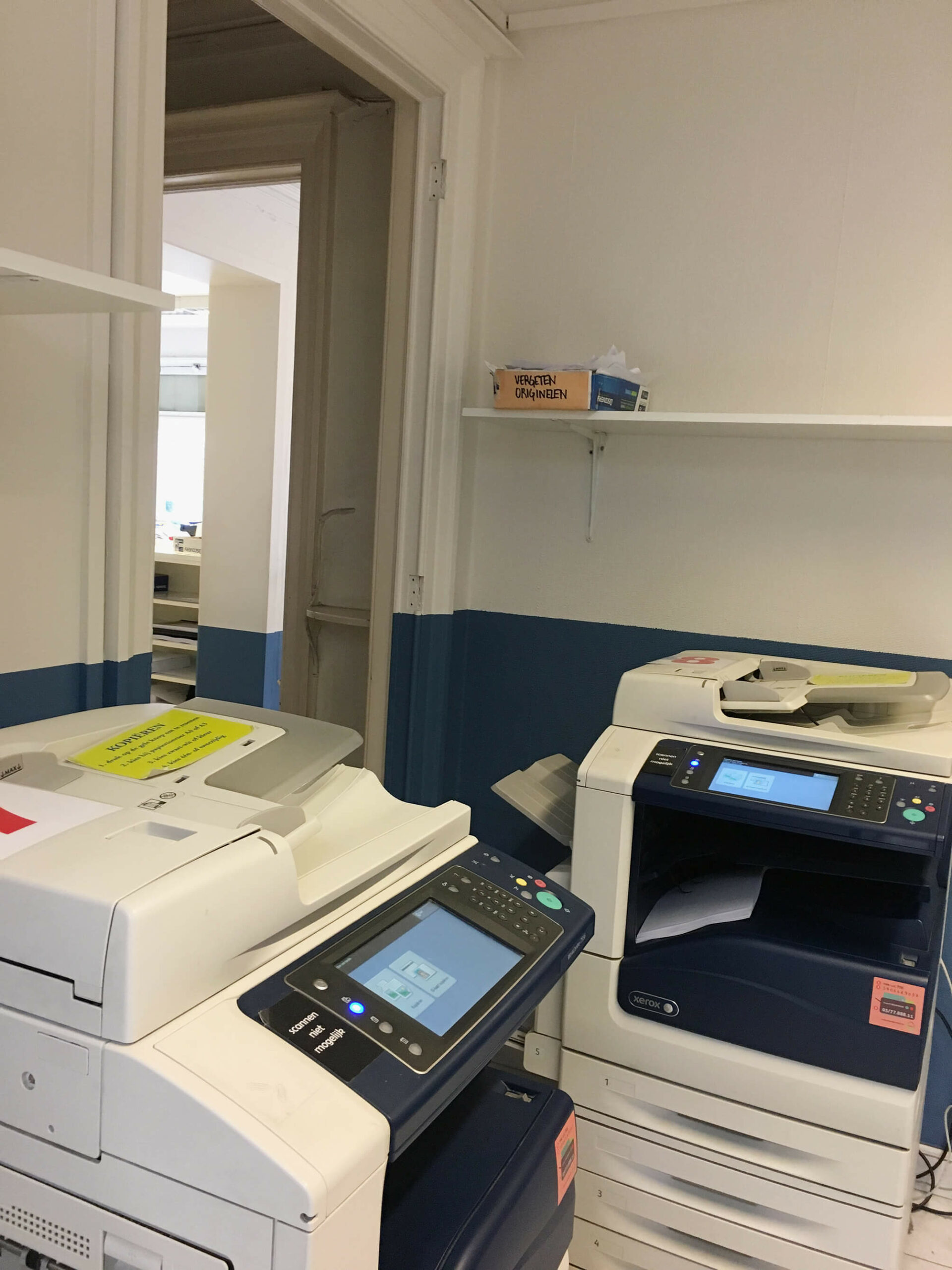
The architect’s photographic archive contains seven images that can be labelled as panoramic pictures. However, they only appear as such when the photographs are viewed in the archive, as strips of negatives. In order to see the panoramic construct, the viewer needs to be presented with two consecutive negatives.
There are two kinds of panorama in the archive: the kind that can only be attributed to a kind of laziness or a need for efficiency on behalf of the architect, and another that originates from frugality.
The former type of panorama is created when the architect is documenting the situation as it is: it is compulsory to document the context of the building or lot, as part of a building application. He simply pivots from left to right, capturing the first and second photograph consecutively. On the filmstrip a panorama appears.
The other kind of panoramic picture only appears at the end of the film role. The last negative on the film has been exposed (the twenty-fourth or thirty-sixth), after which he exerts force onto the lever to move the film forward anyway. Some films are known to have, by accident, a twenty-fifth or a thirty-seventh negative. The plastic between the sprocket holes tears and the film does not advance enough. The result differs fundamentally from the other kind of panorama: there is no separation, no void between the negatives. Rather, there is a slight overlap. A thin, vertical strip of film that has been exposed twice, suggesting contiguity that might not be there. The two exposures might be from altogether different sites, creating a new situation.
Based on De Cleene, M. & De Cleene, A. The Situation as it Is. A Photonovel in Three Movements. Gent: APE, 2022
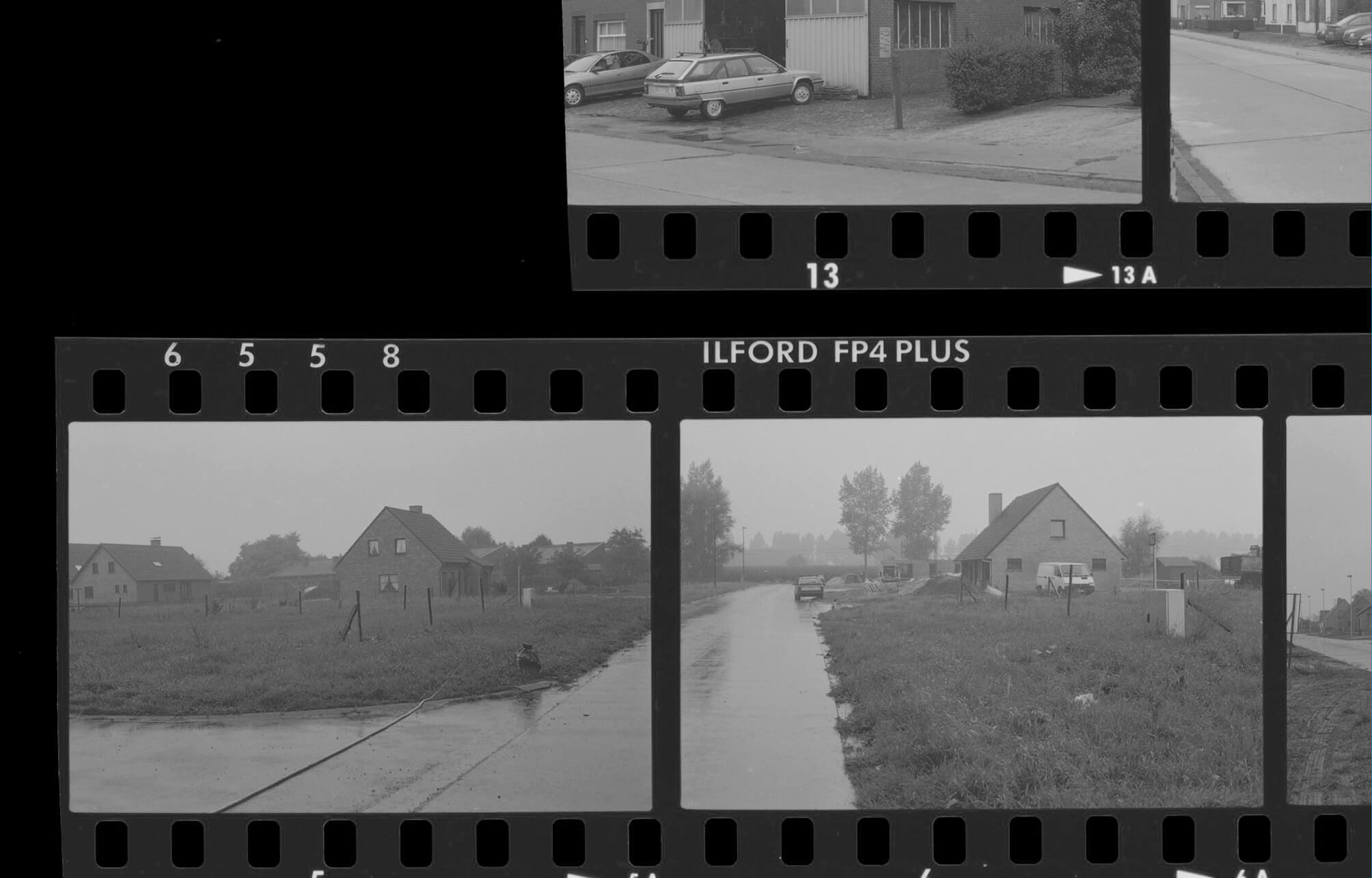
The previous owners of the house we moved into, left us a piece of a newspaper that was used to clad the wall at the time the building was built, and which they found when they renovated the house. The sport-section of the socialist newspaper Vooruit is dated 18 November 1931. It features articles on cycling and soccer. Recently, we noticed the plaster is coming off the wall in one corner of the living room. With sufficient rain, it might reveal other events that happened on that 1931 November Wednesday.

The scientific exactitude sought for in the Iconographie de la Salpêtrière and the Nouvelle Iconographie de la Salpêtrière, the (in)famous scientific publications stemming from Paris’ psychiatric hospital La Salpêtrière (1876-1918), lead to an abundance of photographic images in their pages. The photographs’ ideal: ‘Trace incontestable, incontestablement fidèle, durable, transmissible’.1 The ambition of exactitude results in cold, and often cruel depictions of patients. In the digitized version of the Sorbonne library’s copies, some photographs have left an imprint on the opposite page. The knee of Charles, ‘le géant’, adds an unwanted layer upon its measures on the opposite page, while the photograph of the knee itself loses ink.2
Didi-Huberman, G. Invention de l’hystérie. Paris: Macula, 2014, 72.
Launois, P.-E., Roy, P., ‘Gigantisme et infantilisme’, Nouvelle Iconographie de la Salpêtrière, Tome XV, 1902, 548, pl. LXVI, online: https://patrimoine.sorbonne-universite.fr/fonds/item/2613-nouvelle-iconographie-de-la-salpetriere-tome-15?offset=6


I’m taking a scan of a family photo album given to me after my grandmother passed away, wanting to write something about the marvelous portraits inside. The genealogy is only partly clear to me: I recognize my dad as a kid, my uncle, my grandmother, her brother in the laboratory he (said he) ran. He smelled of cigars and severe perfume. The older photographs present people I don’t know, but must be my ancestors. My grandmother told me stories1 that, historically, reach further back than the figures I recognize in the photographs. There are no names and no dates in the album. The first two pictures seem to be the oldest ones.2 I retract them from the album pockets in which they were slid to check if something is written on the backside. When I take the album away from the scanner’s glass plate, particles of leather, gold varnish and sturdy cardboard come loose. I place a sheet of paper on the glass plate and press ‘scan’ again.
Once she (my grandmother) went home from school, sick, with her bicycle. She studied to become a nurse. The school was in Brussels, about 60 kilometers from her native village M. The milkman’s van tipping over in front of my grandmother’s parental house. A milk covered street. My great-grandfather, physician and mayor at M. Something happened during the Second World War having to do with telephones or radios when she was still a kid.
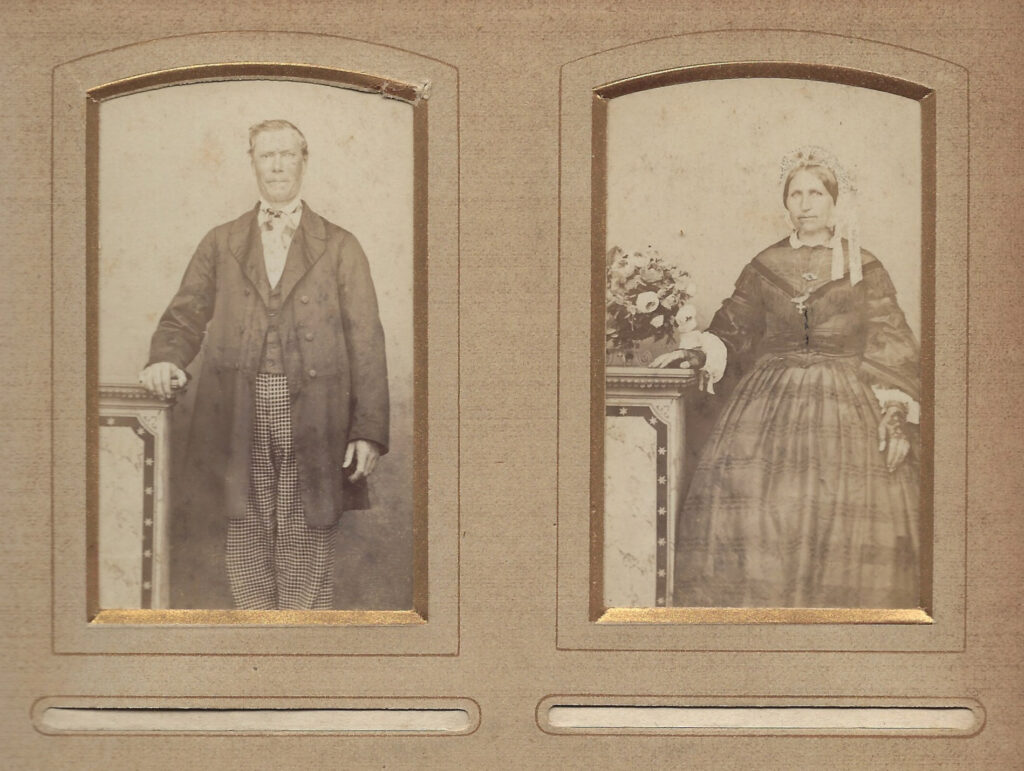
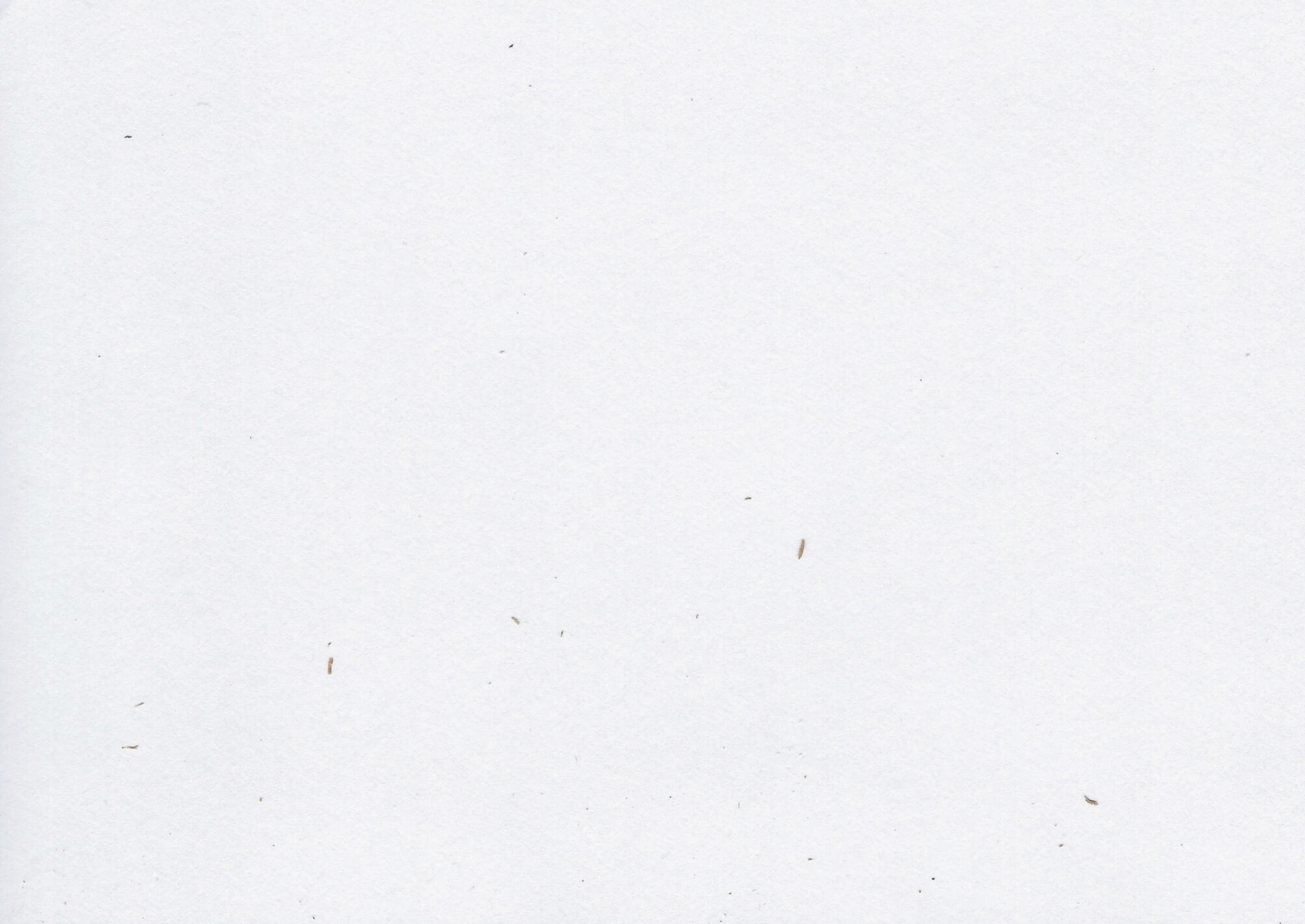
Today I brought an old bedspring, the styrofoam the air-humidifier came in, a few bags of sawdust and some scrap pieces of plywood to the municipal recycling center. As I was waiting to mount the stairs to the scrap metal container, a gray-haired man wearing blue leather shoes, dark jeans and a checkered shirt was tipping – with relative ease – a weight bench over the edge of the container.
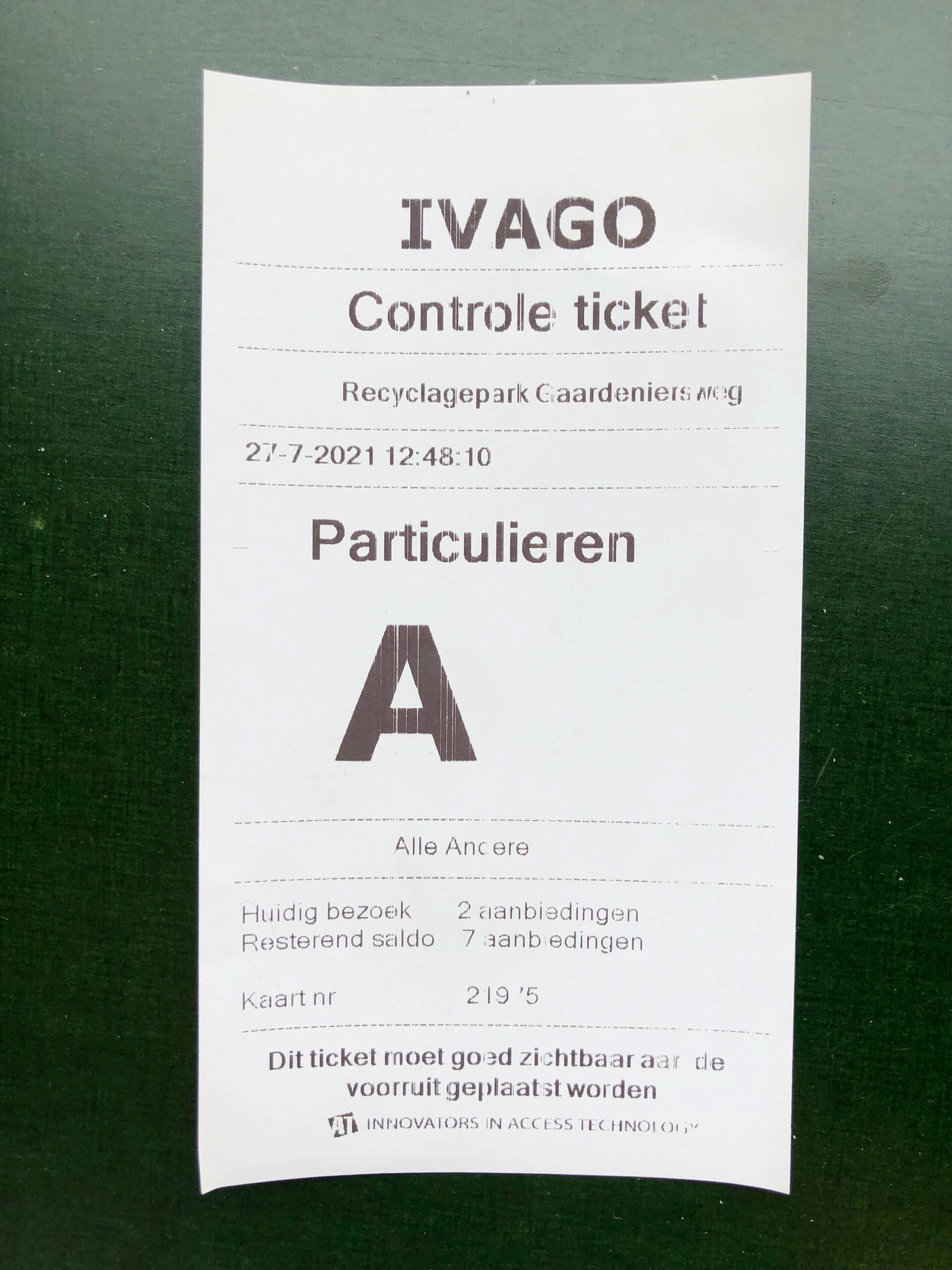
The previous owners of the house we moved into, left us a piece of a newspaper that was used to clad the wall at the time the building was built, and which they found when they renovated the house. The sport-section of the socialist newspaper Vooruit is dated 18 November 1931. It features articles on cycling and soccer. Recently, we noticed the plaster is coming off the wall in one corner of the living room. With sufficient rain, it might reveal other events that happened on that 1931 November Wednesday.

What they took for ice that slid down the dam’s slope, appears to be the reason for draining the reservoir: a fissure in the watertight layer. The dam became unreliable.
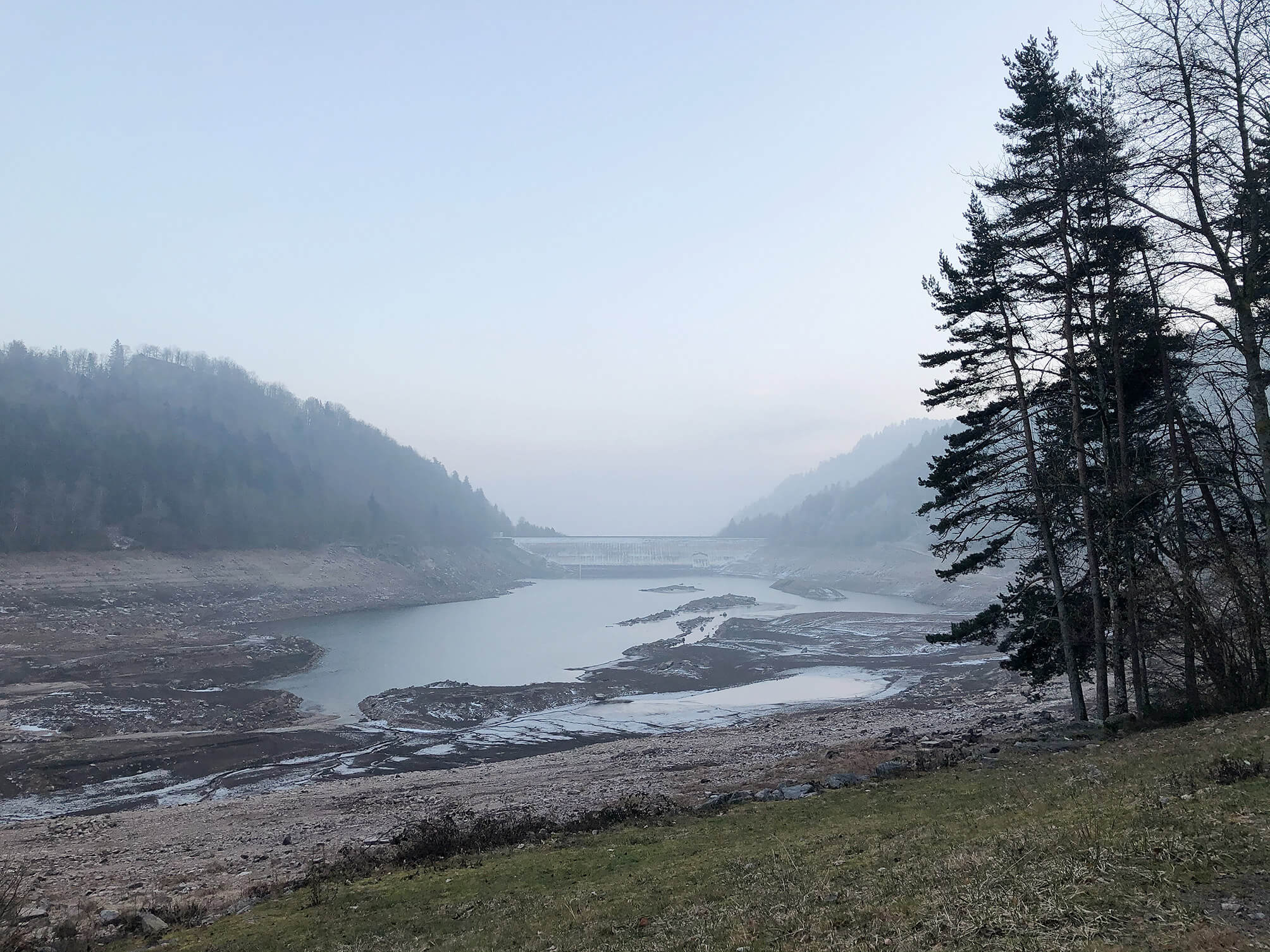
On 29 September 2022, I find a picture of a new Sparta K-10 on the website of cyclonewebshop.be. The bike is matt black and has a chaincase and a nice luggage rack at the front. The typical loop at the back is less noticeable in this photo. This is partly due to the colour of the bike.
Lars Kwakkenbos lives and works in Brussels and Ghent (B). He teaches at KASK & Conservatorium in Ghent, where he is currently working on the research project ‘On Instructing Photography’ (2023-2024), together with Michiel and Arnout De Cleene.

K. says that the stall where he usually buys fruit has already been packed up. But he is not worried about the quality of the fruit the other vendor sells. He gestures encouragingly.
Five signs of type-1, eleven of type-2 and two of type-3 are visible. Four of type-2 (two visible, two deduced) and two of type-3 retain two vehicles.



Márk Redele pursues projects that fundamentally relate to architecture and its practice but rarely look like architecture. www.markredele.com

On 29 September 2022, I search the internet for the factory details of an original Sparta K-10. First I come across some second-hand K-10s. On marktplaats.nl, a Sparta K-10 is for sale for 60 euros, but anyone interested may also make an offer. The seller’s name is Tineke. She lives in The Hague and writes that the bike is ‘easy to take along’. The K-10 she is selling has no chain guard, but it does have a chrome luggage rack. This makes the bike more practical, but in my opinion also less attractive. Her bike also has a bell, but no elegant loop at the end of the long, curved tube around which the frame is built – most other K-10s do have such a loop – or has it disappeared behind the top tube of the luggage carrier? If Tineke is also the owner of the bike, she is much taller than the owner of the Brussels bike, as her saddle is a lot higher, and it is also more or less straight. Moreover, the handlebars are very high thanks to a different stem, which makes the model of the bike a bit unbalanced. I don’t know if I would have photographed the bike for sale in The Hague.
Lars Kwakkenbos lives and works in Brussels and Ghent (B). He teaches at KASK & Conservatorium in Ghent, where he is currently working on the research project ‘On Instructing Photography’ (2023-2024), together with Michiel and Arnout De Cleene.
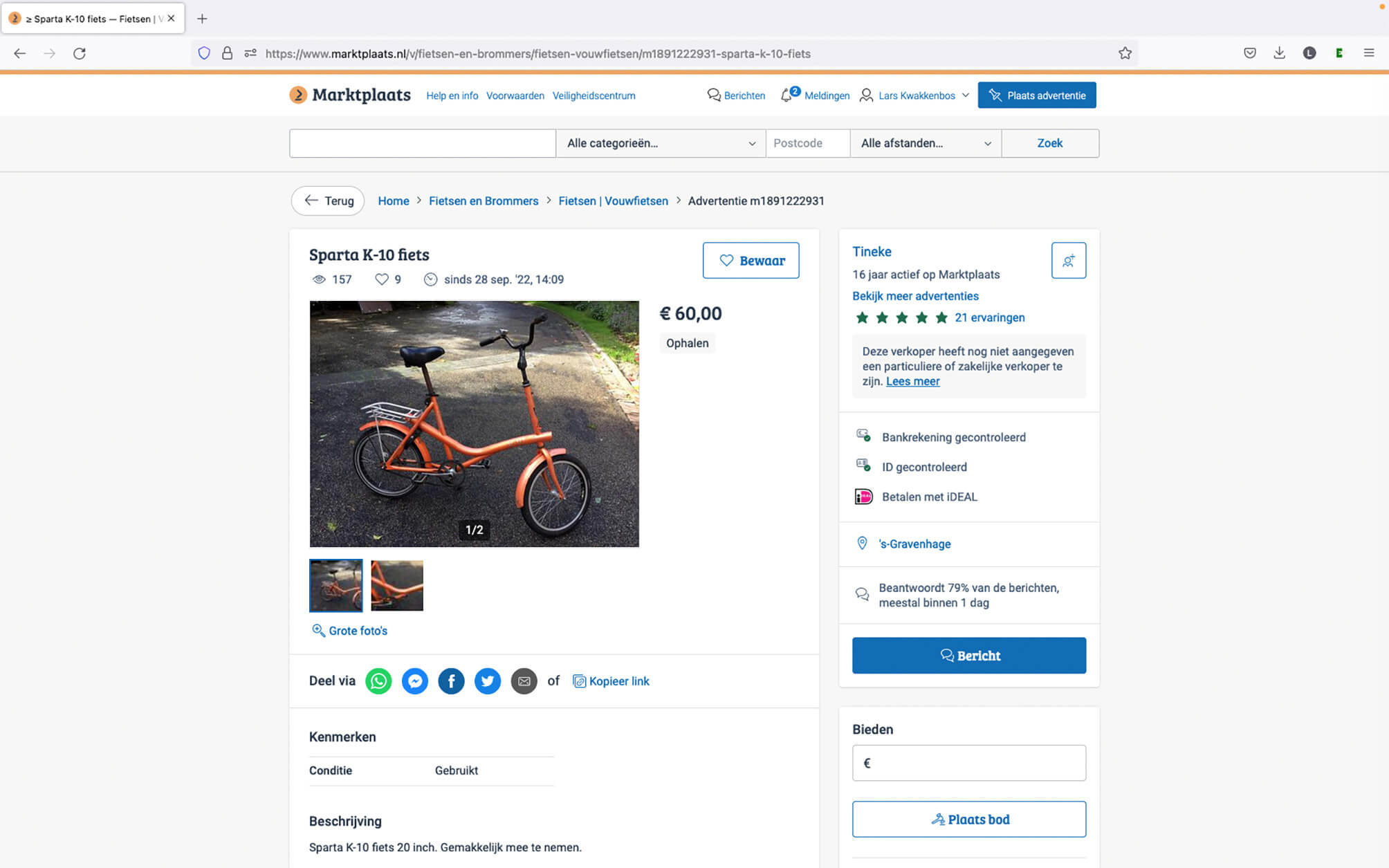
(‘Imaginary landscape in the actual greater Gent, some thousands of years ago. A grassy riparian zone separates rivers from the edge of the forests’)
Imagine a deserted city of Gent, overtaken by nature, Thiery asks the reader in his book Het woud (The Forest). After fifty years, you return to the city. Buildings have collapsed, streets are overgrown. It has become an impenetrable, dense forest, except for the river on which the reader makes his or her way through it. In the first half of the twentieth century, Leo Michel Thiery made one of Belgium’s first botanical gardens for educational purposes. In the middle of an industrialized quarter of the city of Gent, the garden presented different sceneries. There were landscapes from the Alps, dunes, the Ardennes, steppe. Besides sceneries with chalk-, loam-, marl- and sand-based vegetation, there were forests, grasslands and swamps.
After his death, Thiery’s garden decayed. Decades later, it was restored, with the Alps, dunes, the Ardennes and steppe now classified as a protected view.
Thiery, M. Het woud. Een proeve van plantenaardrijkskunde. Gent: De Garve, s.d., p. 14
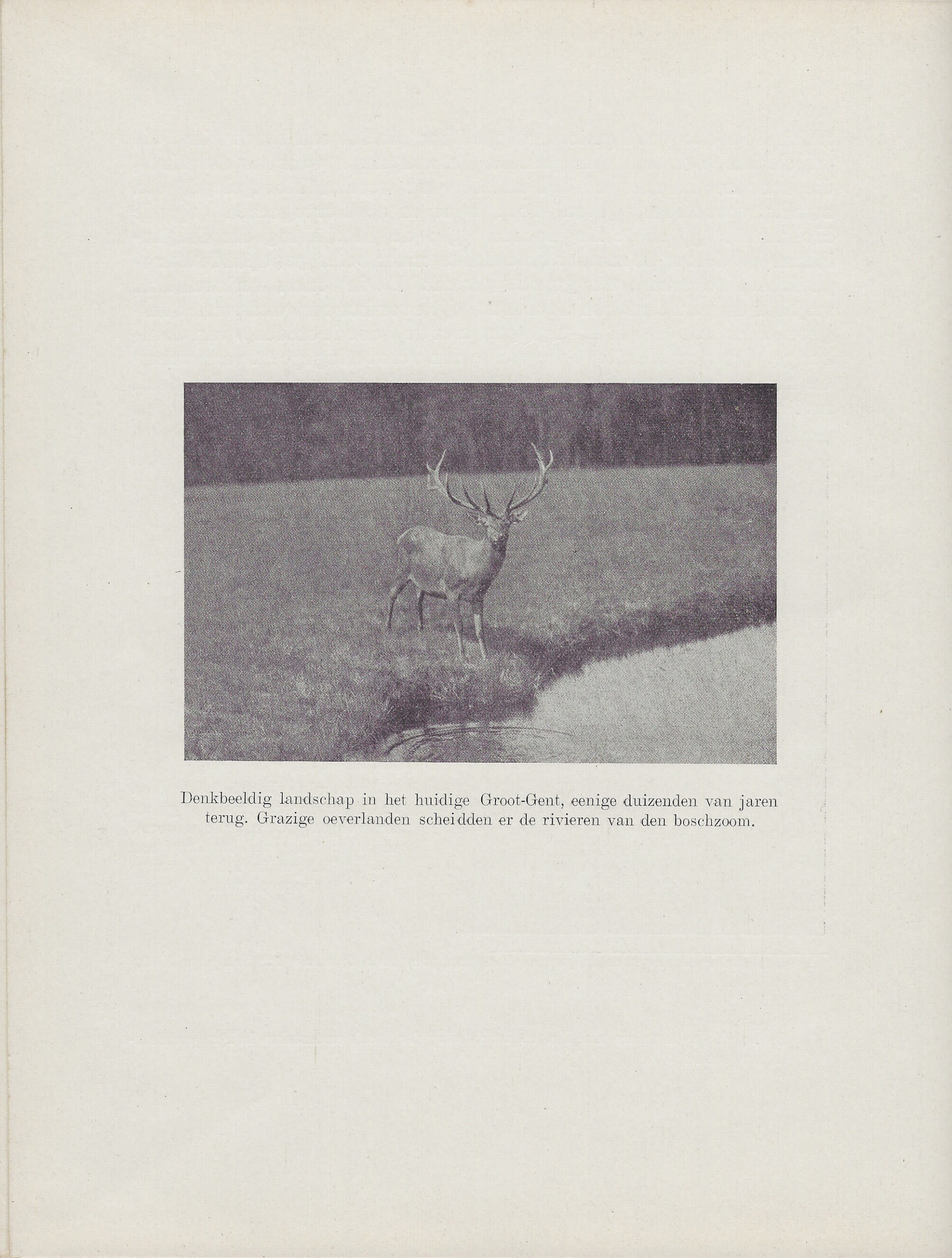
Depending on the language one chooses, the Wikipedia entry for ‘document’ shows a different picture. The French-language page shows what appears to be a Slovenian thesis written in 1984. The caption states it is a ‘book of Czechoslovak computer science author Květoslav Šoustal about computer networks’. The image was uploaded by Kelovy, a Slovakian mushroom-picker.
The anonymous hand rests on a lemon-yellow tablecloth, on which a yellow book and a blue binded file lie. The top left corner is the most intriguing, however: the tablecloth seems to be draped over a lemon, alongside a drinking glass. The cloth, however, does not get shaped by the lemon. Nor does the shadow-side of the lemon coincide with the shadow the other documents throw on the tablecloth. A closer look seems to indicate that the lemon is in fact an image of a lemon, printed on a plastic napkin.
The Russian wikipedia shows the image of a lease agreement. The German wikipedia for ‘document’ is text only.
https://fr.wikipedia.org/wiki/Document#/media/Fichier:KVETOSLAV_SOUSTAL_BOOK.JPG, created October 3, 2006 / original in original: paper, 1984

In summer, the roofing gets hot and soft. In winter, it gets cold, hard and brittle. None of the gates to the garages are open. It’s unsure whether the numerous texts and drawings – some dig deeper than others – have caused leakages.

At the beach of Cap d’Antifer in Normandy one can find ‘sea glass’ between the pebbles: pieces of broken glass that have naturally weathered by being tumbled by the ocean, over and over. Sharp edges and smooth surfaces vanish. The historical origin of the glass pebbles (glass bottles, a shipwreck) erodes. Only the colour of the pebbles gives an indication of their history, be it vaguely. Varieties of green sea glass are common, but other colours, such as red (Shlitz beer bottles) or yellow (interbellum Vaseline containers), are more rare and have to be sought after attentively.
It’s 4.15 PM. The tide is pushing three people towards the cliffs.

It must have been four or five years ago, that I noticed the change in Tabasco’s® up until then stable, unchanged and thus kind of unfashionable presence in supermarkets (vinegar section). On one of the box’s sides, there had always been a photograph of a man, clipboard in hand, looking upwards to a huge wooden barrel full of Tabasco®. He was inspecting something, from the outside, writing it down.
A couple of years ago, the man disappeared from the packaging. I think he was replaced by a pizza (as one of the suggestions for using Tabasco® on, besides on hashed meat (with an egg yolk, fries and lettuce) and spaghetti bolognese) or a black-and-white image of a part of an oak barrel. It is unclear who is inspecting the barrels now.

(transcript CNN Saturday morning news, Aired September 21, 2002 – 07:32 ET)
THIS IS A RUSH TRANSCRIPT. THIS COPY MAY NOT BE IN ITS FINAL FORM AND MAY BE UPDATED.
MILES O’BRIEN, CNN AnchorNow this Astronomy Picture of the Day goes back as far as the popularization of the Internet. The discovery of what is now Netscape, if you will. Let’s take a look at the guys behind it. It’s an art gallery of astronomy, featuring explosive supernovas, deep black holes, flaring comets, and breathtaking earth views.
(BEGIN VIDEOTAPE)
O’BRIEN(voice-over) Every day since the web was in its infancy, two enthusiastic astronomers have posted a new image to Astronomy Picture of the Day.
ROBERT J. NEMIROFF, NASA Astrophysicist
I think that a lot of these would look great in a gallery. They’re very different, there’s a lot of different colors involved, there’s a lot of different contrasts, a lot of different textures. And, it has the added bonus of being scientifically interesting. It’s scientifically true.
O’BRIENRobert Nimiroff and Jerry Donnell (ph) choose the images based on their educational value, newsworthiness, or just plain beauty.
NEMIROFF
I mean, there’s a ‘wow’ factor here. I usually know within a second or two of seeing a picture whether it’s a sure thing for The Astronomy Picture of the Day, because I just say ‘Wow, what is going on there?’
O’BRIENEvery image is archived on the site. Underneath each picture is a brief explanation so that the site is not just eye candy but educational, as well. Including images that give us a new perspective.
NEMIROFF
Recently, people put together a bunch of pictures from the moon in this great panorama. You can look all the way around in the circle and see what the astronauts saw. The face on Mars, which the best explanation is, it’s just a rock formation, but there’s a lot of conspiracy people out there who think it’s more, and the picture of the earth at night. And, I think it’s one of our most popular images.
O’BRIENSome images come from telescopes around the world. Others from the Hubble Telescope, peering deep into space. Others, from amateur photographers, an artist’s renditions of black holes too distant for detail.
NEMIROFF
And you can just look at it and feel that you’re there.
O’BRIENMany people take the images from the site and post them as wallpaper on their computers, or, create a slideshow screensaver.
NEMIROFF
Our biggest demographic is the intelligent professional who works at some company and has a computer on the desk, has a web browser, and they check us out. We’ve got e-mail that we’re many people’s morning cup of coffee.
O’BRIENWhether you’re a space junkie or just enjoy looking up at the sky, Astronomy Picture of the Day is worth the visit.
https://apod.nasa.gov/apod/ap950616.html (original post: June 16, 1995)
http://transcripts.cnn.com/TRANSCRIPTS/0209/21/smn.06.html

Because an acquaintance of the family was a missionary, the postage stamp collection had a large quantity of stamps from the Philippines. You had to boil water, hold the empty envelope above it, wait until the glue and the missionary’s saliva loosened and evaporated, and then gently peel off the stamp. Then, it was put on a piece of pink blotting paper. Once dry, the stamp was slid into a tailor-made booklet.
Between a Horta building’s facade and King Baudouin’s portrait, there are exotic fish, religious scenes, butterflies, and advertisements for NGOs.
Mango is the Philippines’ national fruit. Pope John Paul II visited it in 1995. There was a guerrilla unit in Northwest Pampanga during WWII.
